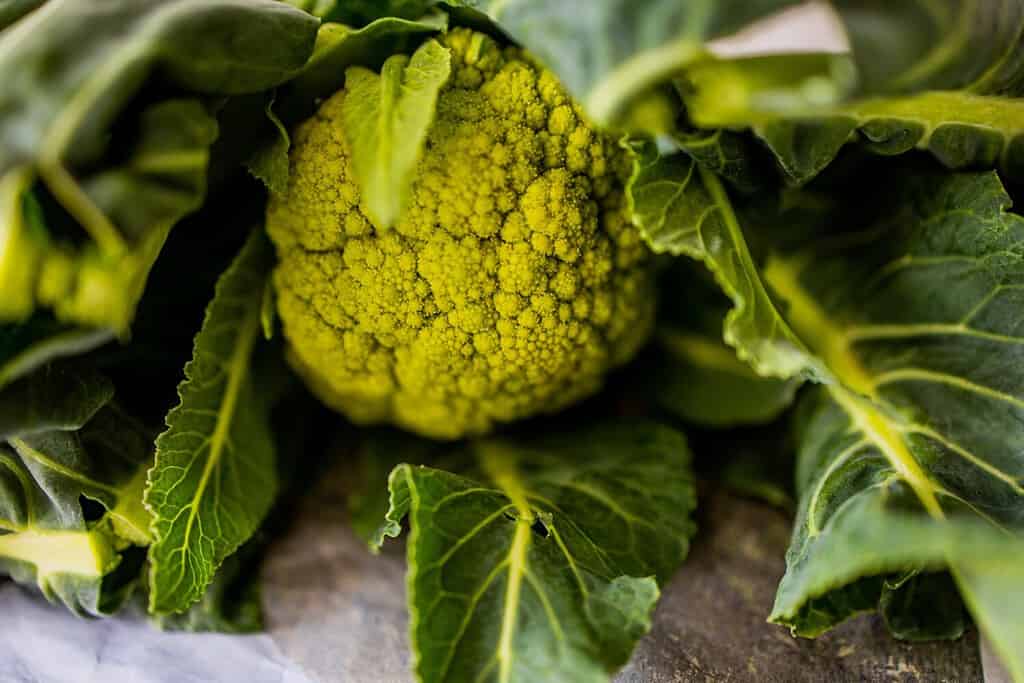Whip up some homemade Thousand Island dressing, dip a piece of steamed cauliflower into the dressing, and voila, you have a great snack. It’s delicious and nutritious! Of course, when we think of cauliflower, we mostly only think of one color — white. Several white fruits and vegetables come to our mind — onions, lychees, garlic, and turnips, to name a few.
What most people don’t know is there are different colors of this cruciferous vegetable. You know this about apples, onions, and maybe even carrots, but bet you didn’t know this fact about cauliflower!
Now you know. Now let’s delve into each color of cauliflower — explore their history, health benefits, and more. We’ll start with the rarest color and work our way up to the most common.
Orange Cauliflower

The top six producers of cauliflower in the world are China, India, the United States, Spain, Mexico, and Italy.
©Brent Hofacker/Shutterstock.com
History
When you look at it, it almost looks like a cheddar ball. Its color is extremely unique because you don’t normally see it on a cauliflower. It first showed up naturally in 1970 at a farm in Canada and from there, the seeds went to the New York State Agricultural Station, which is part of Cornell University, to be studied. Eventually, by the early 1980s, it was introduced to the public and it wasn’t popular at all. The orange color was just too weird. Fast forward thirty years and its color is now something unique that restaurants and grocers love.
Flavors and Uses
Orange cauliflower is nutty and sweet, and when pureed, it can be creamier than other types of cauliflower. They are used in a variety of ways just like white cauliflower is used — as appetizers, smoothies, side dishes, or even snacks. Orange cauliflower can be in water, boiled, or steamed, and luckily will not lose its color.
Health Benefits
Orange cauliflower has 25% more beta-carotene than its white counterpart, which means they are actually healthier. This is, of course, because of its orange color. They have vitamin C and vitamin A, as well as small amounts of iron, potassium, magnesium, and calcium. Orange cauliflower also has fiber, which is fantastic for the digestive system.
Purple Cauliflower

Some cool cultivar names of cauliflowers include the Green Goddess, Flame Star Hybrid, White Corona Hybrid, Sicilian Violet, and Graffiti Hybrid.
©NLLC/Shutterstock.com
History
Purple cauliflower was crossbred to get a better or more modern color. The result was a mutation, which was the purple cauliflower. It was most probable that the mutation contained more anthocyanin, the pigment that makes vegetables, fruits, and plants turn red, blue, or purple. While not necessarily popular, at the turn of the 21st century, colored cauliflowers became avant-garde, and purple cauliflower started to sell at grocery stores and restaurants.
Flavors and Uses
Purple cauliflower is sweet and nutty and can be used for many things. It can be roasted, grilled, mashed, steamed, or boiled. However, because of their color, many chefs do not like putting them in water because they will lose their vibrant pigmentation. This pigmentation is what makes them attractive when cooking them at restaurants. This color cauliflower is great to serve as appetizers or in salads because they will stand out.
Health Benefits
Purple cauliflower has amazing health benefits. Because of its color, it has anthocyanins, which can be a good antioxidant for humans. The purple cauliflower is also a good source of fiber and has potassium, vitamin A, and calcium. Finally, purple cauliflower also has vitamin C to bolden the immune system.
Green Cauliflower

Cauliflowers are cruciferous vegetables along with Brussels sprouts, broccoli, bok choy, and collard greens.
©Lukrecja/Shutterstock.com
History
Green cauliflower is naturally bred with broccoli, which is why green cauliflower looks like a mix of both vegetables. When it comes to the green cauliflower’s history, there isn’t much we know about its origins. In terms of recorded history, green cauliflower was first grown in the Netherlands. It was used in Europe by the mid-1980s but was first introduced in the United States in the late 1980s. Now they are sold throughout the world, but they are not as popular as the white cauliflower.
Flavors and Uses
Green cauliflower is mild and sweet and can be used in several ways. You can have it as a raw snack or you can cook it for more formal meals. Green cauliflower goes great with salads and harvest bowls, but it can also be used in smoothies because of its great nutritional value. Green cauliflower can also be used as side dishes (or pureed like mashed potatoes) with meat or as a healthier alternative to pizza dough.
Health Benefits
The health benefits of green cauliflower are vast. It is rich in vitamin C, which keeps the immune system strong. Green cauliflower is also good for your digestive system and a great source of fiber. It also has a good amount of vitamin A to ensure healthy organs. Green cauliflower is known to have folic acid and copper, as well, which means it can help with oxygen intake and your nervous system.
White Cauliflower

Although more popular in Europe, the British were the ones to introduce cauliflower to India in 1822.
©iStock.com/Baloncici
History
At last, we come to the most popular cauliflower — the white cauliflower! The cauliflower is a genetically engineered vegetable that was created using hybrids of other vegetables. The cauliflower was invented in the Mediterranean region with historians pointing to Cyprus as the likely country where they created this cruciferous vegetable. The first time the cauliflower was reported in history was 1748 and soon after, it spread throughout the world. Fascinatingly, President George Washington had cauliflower in his garden at Mount Vernon. But it wasn’t until the early 1900s that the use of cauliflower in the United States became widespread.
Flavors and Uses
The reason behind cauliflower’s white color is that the leaves cover the head, which means it gets no direct sunlight. The white cauliflower, like all others, tastes a bit nutty and sweet. There is no change in flavor from the other cauliflowers. There are several types of white cauliflower available throughout the world. Roast them, grill them, steam them — there are many ways to eat a cauliflower!
Health Benefits
White cauliflower has an abundance of health benefits. In fact, all cruciferous vegetables — from arugula to broccoli, and bok choy to kale — have immense benefits. Cauliflower provides the fiber you need, which leads to a healthy stomach. It is also great as a cancer protector because it has glucosinolates. Cauliflower also has a good amount of vitamin C, vitamin K, and vitamin B9. Doctors have agreed that cauliflower can cause gas or bloating, so be aware of that.
Conclusion
And there you have it, the different colors of cauliflower from rarest to most common are brown, orange, green, purple, and white. The cool thing is that there are varieties abundant within each color. Many cultures use different cauliflowers for a variety of uses, from cooking to medicinal purposes. Although the white one is the most popular, the other three have become more available in recent years. These vegetables could have originated around Cyprus and the Mediterranean region, but they spread all over the world.
If you enjoy planting and gardening, having a rainbow-colored cornucopia of cauliflowers can turn your garden into a colorful paradise. And while you explore meals to cook for your family on weekends, consider buying a different colored cauliflower each week to spice things up. It will make your salad or entire meal more colorful. It will be a rainbow of cauliflowers!
4 Different Colors Of Cauliflower (Rarest to Most Common)
| Cauliflower Color | Scientific Name |
|---|---|
| Orange | Brassica oleracea var. botrytis |
| Purple | Brassica oleracea var. botrytis |
| Green | Brassica oleracea var. botrytis |
| White | Brassica oleracea var. botrytis |
The photo featured at the top of this post is © Animaflora/iStock via Getty Images
Thank you for reading! Have some feedback for us? Contact the AZ Animals editorial team.







